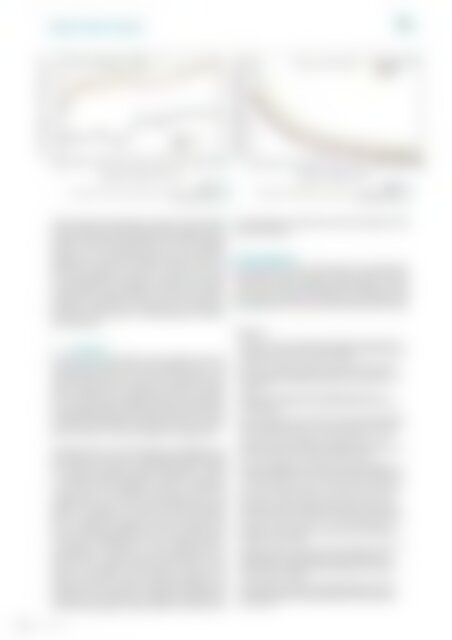atw - International Journal for Nuclear Power | 2.2024
Internationale Entwicklungen und Trends
Internationale Entwicklungen und Trends
You also want an ePaper? Increase the reach of your titles
YUMPU automatically turns print PDFs into web optimized ePapers that Google loves.
Research and Innovation<br />
73<br />
Fig. 11.<br />
Comparison of the Fuel temperature coefficient of FCM fuel<br />
with Standard fuel.<br />
Fig. 12.<br />
Comparison of Moderator temperature coefficient of FCM<br />
and Standard fuel<br />
neutron spectrum hardening. Contrary to FTC, the MTC<br />
remains positive and decreases monotonically with the<br />
increase in moderator temperature. The MTC remains<br />
positive <strong>for</strong> the standing fuel until the moderator<br />
temperature reaches 900 K (600 K increase from the<br />
reference temperature). While the MTC <strong>for</strong> UCO and<br />
UN remain positive because the moderator density<br />
remains higher than 700 kg/m³. However, the moderator<br />
density is 725 kg/m³.Moreover, with the increase in<br />
moderator temperature the density of the moderator<br />
decreases which results in diminishing the neutron<br />
thermalization.<br />
4. Conclusion<br />
In this work, the FCM fuel has been replaced with the<br />
conventional design fuel of the SMART reactor. The<br />
FCM fuel based on the UN and UCO carbide kernel of<br />
850 mm and 870 mm respectively has been investigated.<br />
The FCM fuel was replaced without the alteration<br />
of core design and fuel pallet dimensions alterations.<br />
The candidate designs of UCO started at 87.3 % less fertile<br />
238U and about 28 % of fissile material 235U, while<br />
the UN cases are 79.78 % and 28.84 %, respectively.<br />
FCM fuel presents several significant challenges from<br />
the perspective of reactor engineering. Retrofitting of<br />
UO₂ with the FCM fuel in the existing LWRs or SMRs<br />
is a significant difficult problem. The initial reactivity<br />
in the FCM fuel assemblies required a significant<br />
consideration of burnable poison (dissolved or rod<br />
positions). However, in the case of dissolved burnable<br />
poison is a challenge as it alters the coolant chemistry<br />
that is sufficient to suppress the BOL reactivity and<br />
result in a stable equilibrium cycle. It is evident that <strong>for</strong><br />
the realistic configuration, the fuel length would be<br />
compromised in reference to the conventional UO₂<br />
fuel. However, the Cycle length of 800 EFPDs is acceptable<br />
<strong>for</strong> the SMART reactor when the safety of the<br />
reactor is ascendent. From the safety perspective, the<br />
FCM has fuel, has less PPF, and has less negative fuel<br />
temperature and moderator coefficient throughout the<br />
fuel operating length. Finally, SMART reactors can be<br />
operated safely <strong>for</strong> 850 EFPDs with the FCM fuel of UN<br />
and UCO Kernels<br />
Acknowledgment<br />
This research work was funded by the institutional<br />
fund projects under the grant number (IFPIP: 120-135-<br />
1443). The authors gratefully acknowledge technical<br />
and financial support provided by the Ministry and<br />
King Abdulaziz University, DSR, Jeddah, Saudi Arabia.<br />
Reference<br />
[1] Chun, J.H.; Lim, S.W.; Chung, B.D. Safety evaluation of accident-tolerant<br />
FCM fueled core with SiC-coated zircalloy cladding <strong>for</strong> design-basis-accidents<br />
and beyond DBAs. Nucl. Eng. Des. 2015, 289, 287–295.<br />
[2] Snead, L.L.; Terrani, K.A.; Venneri, F. Fully ceramic microencapsulated<br />
fuels: A trans<strong>for</strong>mational technology <strong>for</strong> present and next generation<br />
reactors- properties and fabrication of FCM fuel. Trans. Am. Nucl. Soc. 2011,<br />
104, 668–670.<br />
[3] Snead, L.L.; Terrani, K.A.; Katoh, Y. Stability of SiC-matrix microencapsulated<br />
fuel constituents at relevant LWR conditions. J. Nucl. Mater.<br />
2014, 448, 389–398.<br />
[4] Lu, C.; Hiscox, B.D.; Terrani, K.A. Fully ceramic microencapsulated fuel in<br />
prismatic high temperature gas-cooled reactors: Analysis of reactor per<strong>for</strong>mance<br />
and safety Characteristics. Ann. Nucl. Energy 2018, 117, 277–287.<br />
[5] C. Gentry, N. George, I. Maldonado, A. Godfrey, K. Terrani, J. Gehin,<br />
Application of fully ceramic microencapsulated fuels in light water reactors,<br />
in: Int. Congr. Adv. Nucl. <strong>Power</strong> Plants 2012, ICAPP 2012, 2012.<br />
[6] C. Gentry, I. Maldonado, A. Godfrey, K. Terrani, J. Gehin, J. <strong>Power</strong>s, A<br />
Neutronic Investigation of the Use of Fully Ceramic Microencapsulated Fuel<br />
<strong>for</strong> Pu/Np Burning in PWRs, Nucl. Technol. 186 (2014). doi:10.13182/nt13-75.<br />
[7] Terrani, K.A.; Kiggans, J.O.; Katoh, Y. Fabrication and characterization of<br />
fully ceramic microencapsulated fuels. J. Nucl. Mater. 2012, 426, 268–276.<br />
[8] Al-zahrani, et al 2021. Neutronic per<strong>for</strong>mance of fully ceramic microencapsulated<br />
uranium oxycarbide and uranium nitride composite fuel in<br />
SMR. Annals of <strong>Nuclear</strong> Energy, 108152, DOI: 10.1016/j.anucene.2021.108152.<br />
[9] Terrani, K.A.; Zinkle, S.J.; Snead, L.L. Snead, Microencapsulated fuel<br />
technology <strong>for</strong> commercial light water and advanced reactor application. J.<br />
Nucl. Mater. 2012, 427, 209–224.<br />
[10] Venneri, F., Kim, Y., Snead, L.L., Terrani, K.A., Ougouag, A., Tulenko, J.E.,<br />
Forsberg, C.W., Peterson, P.F., Lahoda, E.J., 2011. Fully ceramic microencapsulated<br />
fuels: a trans<strong>for</strong>mational technology <strong>for</strong> present and next<br />
generation reactors-preliminary analysis of FCM fuel reactor operation.<br />
Trans. Am. Nucl. Soc. 104 (668).<br />
[11] Pope, Michael A., Sonat Sen, R., Ougouag, Abderrafi M., et al., 2012.<br />
Neutronic analysis of the burning of transuranics in fully ceramic microencapsulated<br />
triisotropic tri-isotropic particle-fuel in a PWR. Nucl. Eng.<br />
Des. 252. 215-225<br />
Vol. 69 (2024)
















